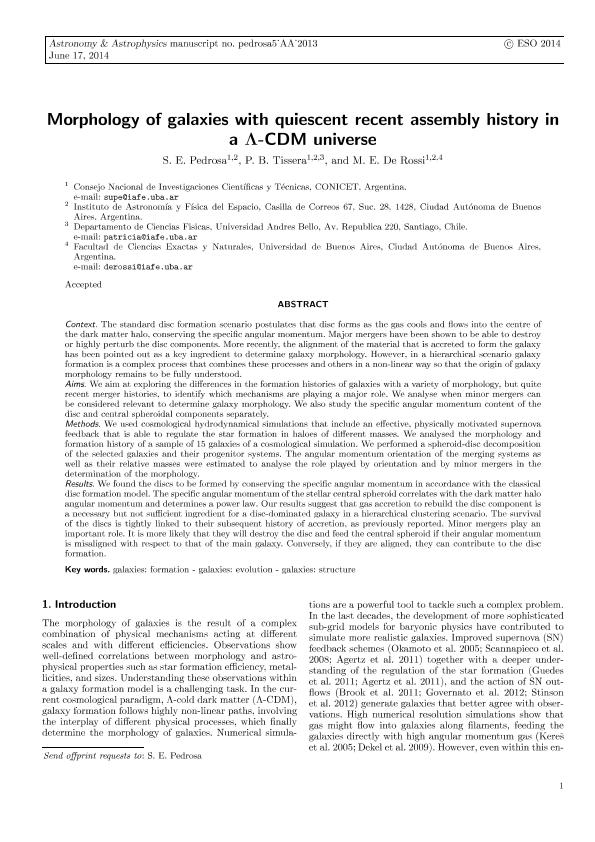Mostrar el registro sencillo del ítem
dc.contributor.author
Pedrosa, Susana Elizabeth

dc.contributor.author
Tissera, Patricia Beatriz

dc.contributor.author
de Rossi, Maria Emilia

dc.date.available
2017-07-26T21:13:57Z
dc.date.issued
2014-07
dc.identifier.citation
Pedrosa, Susana Elizabeth; Tissera, Patricia Beatriz; de Rossi, Maria Emilia; Morphology of galaxies with quiescent recent assembly history in a Λ-CDM universe; EDP Sciences; Astronomy and Astrophysics; 567; A47; 7-2014; 1-9
dc.identifier.issn
0004-6361
dc.identifier.uri
http://hdl.handle.net/11336/21401
dc.description.abstract
Context. The standard disc formation scenario postulates that the disc forms as the gas cools and flows into the centre of the dark matter halo, conserving the specific angular momentum. Major mergers have been shown to be able to destroy or highly perturb the disc components. More recently, the alignment of the material that is accreted to form the galaxy has been pointed out as a key ingredient to determine galaxy morphology. However, in a hierarchical scenario galaxy formation is a complex process that combines these processes and others in a non-linear way so that the origin of galaxy morphology remains to be fully understood. Aims: We aim at exploring the differences in the formation histories of galaxies with a variety of morphologies, but quite recent merger histories, to identify which mechanisms are playing a major role. We analyse when minor mergers can be considered relevant to determine galaxy morphology. We also study the specific angular momentum content of the disc and central spheroidal components separately. Methods: We used cosmological hydrodynamical simulations that include an effective, physically motivated supernova feedback that is able to regulate the star formation in haloes of different masses. We analysed the morphology and formation history of a sample of 15 galaxies of a cosmological simulation. We performed a spheroid-disc decomposition of the selected galaxies and their progenitor systems. The angular momentum orientation of the merging systems as well as their relative masses were estimated to analyse the role played by orientation and by minor mergers in the determination of the morphology. Results: We found the discs to be formed by conserving the specific angular momentum in accordance with the classical disc formation model. The specific angular momentum of the stellar central spheroid correlates with the dark matter halo angular momentum and determines a power law. Our results suggest that gas accretion to rebuild the disc component is a necessary but not sufficient ingredient for a disc-dominated galaxy in a hierarchical clustering scenario. The survival of the discs is tightly linked to their subsequent history of accretion, as previously reported. Minor mergers play an important role. It is more likely that they will destroy the disc and feed the central spheroid if their angular momentum is misaligned with respect to that of the main galaxy. Conversely, if they are aligned, they can contribute to the disc formation.
dc.format
application/pdf
dc.language.iso
eng
dc.publisher
EDP Sciences

dc.rights
info:eu-repo/semantics/openAccess
dc.rights.uri
https://creativecommons.org/licenses/by-nc-sa/2.5/ar/
dc.subject
Galaxies Formation
dc.subject
Galaxies Evolution
dc.subject
Galaxies Structure
dc.subject.classification
Astronomía

dc.subject.classification
Ciencias Físicas

dc.subject.classification
CIENCIAS NATURALES Y EXACTAS

dc.title
Morphology of galaxies with quiescent recent assembly history in a Λ-CDM universe
dc.type
info:eu-repo/semantics/article
dc.type
info:ar-repo/semantics/artículo
dc.type
info:eu-repo/semantics/publishedVersion
dc.date.updated
2017-07-26T18:15:05Z
dc.journal.volume
567
dc.journal.number
A47
dc.journal.pagination
1-9
dc.journal.pais
Francia

dc.journal.ciudad
Paris
dc.description.fil
Fil: Pedrosa, Susana Elizabeth. Consejo Nacional de Investigaciónes Científicas y Técnicas. Oficina de Coordinación Administrativa Ciudad Universitaria. Instituto de Astronomía y Física del Espacio. - Universidad de Buenos Aires. Facultad de Ciencias Exactas y Naturales. Instituto de Astronomía y Física del Espacio; Argentina
dc.description.fil
Fil: Tissera, Patricia Beatriz. Consejo Nacional de Investigaciónes Científicas y Técnicas. Oficina de Coordinación Administrativa Ciudad Universitaria. Instituto de Astronomía y Física del Espacio. - Universidad de Buenos Aires. Facultad de Ciencias Exactas y Naturales. Instituto de Astronomía y Física del Espacio; Argentina
dc.description.fil
Fil: de Rossi, Maria Emilia. Consejo Nacional de Investigaciónes Científicas y Técnicas. Oficina de Coordinación Administrativa Ciudad Universitaria. Instituto de Astronomía y Física del Espacio. - Universidad de Buenos Aires. Facultad de Ciencias Exactas y Naturales. Instituto de Astronomía y Física del Espacio; Argentina
dc.journal.title
Astronomy and Astrophysics

dc.relation.alternativeid
info:eu-repo/semantics/altIdentifier/url/https://www.aanda.org/articles/aa/full_html/2014/07/aa23079-13/aa23079-13.html
dc.relation.alternativeid
info:eu-repo/semantics/altIdentifier/doi/http://dx.doi.org/10.1051/0004-6361/201323079
dc.relation.alternativeid
info:eu-repo/semantics/altIdentifier/url/https://arxiv.org/abs/1405.5836
Archivos asociados
